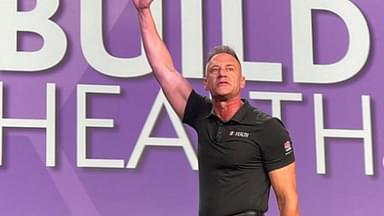In any fitness journey, exercise and nutrition go hand-in-hand to make sure the individual remains healthy throughout their life. ‘Biohacker’ Gary Brecka has often shared some of his go-to protocols or routines to help set a fitness enthusiast’s journey towards success. Yet, with many preconceived notions and assumptions remaining in the food world, it’s difficult to pinpoint what’s true and what’s not. Therefore, he collaborated with Dr. Paul Saladino to talk about the subject.
In an hour-long session, the duo spoke about various forms of diet plans, Dr. Saladino’s nutrition journey, and the debate about the quantity of meat in one’s meal. Brecka posted a clip from the podcast on Instagram where the MD attempted to debunk some common thought processes about the food pyramid that people generally followed.
Commonly, vegetables have always been on the priority tier of any meal. It’s not unfamiliar to have an assortment of plants every day in various forms since they’re rich in fiber and various vitamins and minerals. On the other end of the spectrum, protein-rich meat does not often appear at the forefront of meals. A considerable number of people have traditionally refrained from consuming it.
Dr. Saladino proposed to invert this hierarchy. From his experience, a meat-heavy diet had provided him many benefits despite carrying the title of being unhealthy colloquially. On the other hand, he also suggested pushing plants to the bottom tier. This is because he observed how meat and organs often take center stage in many meals across different groups of people.
“If you look at unprocessed animal and plant foods, which I think can form an incredibly healthy diet for every human, there’s I believe a hierarchy of value in those foods.”
Dr. Saladino firmly believes that meat and organs should be at the center of every diet. Citing the example of the Hadza tribe, he pointed out how their choice of food would always be meat. This is due to them being the last remaining hunter-gatherer tribe.
“For people who have issues that are unresolved, fatigue, anxiety, mental health issues, sleep disturbance…a lot of those people limiting or cutting out the vegetable/plant foods for some amount of time as an experiment is incredibly helpful.”
Diet plans are often subjective to every individual’s needs and preferences, depending on their habits and culture. Dr. Saladino feels that a meat-heavy diet can help transition to the kind of meals human ancestors would have. But the bottom line is to experiment and figure out what works and what doesn’t, which Brecka often preaches about.
Gary Brecka lists a step-by-step solution to hyperthyroidism
In a YouTube video, Brecka described the role of the thyroid hormone. He further pointed out how it was responsible for several functions, including maintaining metabolism, heart rate, calorie burning, etc. Therefore, any imbalance in the thyroid could trigger a domino effect of other issues.
Overproduction of the thyroid hormone leads to hyperthyroidism. Brecka suggested first getting blood work done, followed by identifying the cause of overproduction. Once that’s nailed down, he advised foods rich in selenium, Omega-3 fatty acids, and zinc in the individual’s diet.




